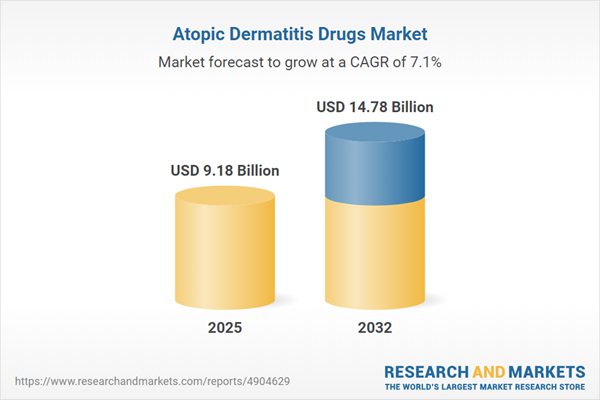Speak directly to the analyst to clarify any post sales queries you may have.
The atopic dermatitis drugs market is undergoing notable transformation as evolving therapies and digital advancements reshape industry standards, challenging senior leaders to continuously align strategies within a complex regulatory landscape.
Market Snapshot: Atopic Dermatitis Drugs Market Growth Outlook
Projected to grow from USD 8.56 billion in 2024 to USD 9.18 billion in 2025 and reaching USD 14.78 billion by 2032, the atopic dermatitis drugs market demonstrates a compound annual growth rate of 7.05%. This expansion is propelled by the increasing prevalence of atopic dermatitis, demand for improved patient outcomes, and rapid adoption of novel treatment modalities. The expedited approval of innovative drugs and integration of digital health solutions into therapy management support ongoing industry momentum. Organizations investing in digital infrastructure and regional diversification are well positioned to navigate market complexity, remain compliant with evolving regulations, and maintain a competitive edge within the global atopic dermatitis space.
Scope & Segmentation of the Atopic Dermatitis Drugs Market
This report provides a robust segmentation structure designed to inform strategic planning, operational agility, and targeted investment for senior leaders in the atopic dermatitis drugs market. A clear understanding of these segments empowers organizations to align resources with shifting patient demographics, emerging digital trends, and varied regulatory requirements worldwide.
- Drug Class: Biologics, small molecule immunosuppressants, calcineurin inhibitors, corticosteroids, PDE4 inhibitors, and vitamin D analogues each serve distinct therapeutic profiles and facilitate product differentiation strategies.
- Route of Administration: Topical formulations—including creams, gels, ointments, and lotions—allow for adaptable patient management approaches in outpatient and clinical settings, driving adherence.
- Mode of Administration: Options such as injectables, oral formulations, pre-filled syringes, and vials optimize operational flow and support scalability across diverse care environments.
- Distribution Channel: Hospital pharmacies, retail networks, and digital sales platforms offer multichannel patient access, expanding geographic reach and resilience against channel disruptions.
- Patient Age Group: Therapeutic targeting for adult, pediatric, and geriatric populations enables development of age-appropriate, personalized care pathways.
- Regions Covered: Americas, Europe, Middle East & Africa, and Asia-Pacific, each region offering unique payer models and regulatory challenges, requiring tailored market approaches to ensure compliance and maximize reach.
- Key Companies Profiled: Regeneron Pharmaceuticals, Sanofi, Pfizer, AbbVie, Eli Lilly, Johnson & Johnson, LEO Pharma, Galderma, Teva Pharmaceutical, and Viatris Inc. are showcased as industry leaders advancing digital technologies and expanding product portfolios.
Comprehensive segmentation supports executives in adapting business models to evolving technology adoption, regulatory expectations, and diverse patient needs across established and developing regions.
Key Takeaways: Strategic Insights for Senior Decision-Makers
- Diversifying drug product portfolios and offering varied administration methods enables organizations to respond swiftly to changing clinical priorities and supports more tailored patient engagement strategies.
- Leveraging digital health platforms, from AI-based diagnostic tools to teledermatology, enhances collaboration between providers and fosters proactive therapy management across distributed care teams.
- Implementing precision medicine, including immunoprofiling, assists in delivering targeted treatments and streamlines resource allocation along the entire patient journey.
- Resilient and adaptive distribution strategies that span hospital, retail, and digital channels safeguard supply integrity and enhance organizational responsiveness to market fluctuations.
- Collaborative research partnerships and licensing agreements enable flexible adaptation to shifts in the regulatory environment and facilitate ongoing innovation.
Applying these strategies helps executives strengthen operational agility, accelerate digital adoption, and build robust risk management practices as the atopic dermatitis drugs market evolves.
Tariff Impact: Regulatory and Supply Chain Considerations
Recent U.S. tariffs on imported pharmaceuticals have introduced new regulatory hurdles and increased supply chain uncertainty for companies operating in the atopic dermatitis drugs market. Addressing these risks requires thorough review of supplier contracts, diversification of sourcing strategies, and proactive pursuit of tariff mitigation options to sustain product continuity in dynamic regulatory conditions.
Methodology & Data Sources
The report’s findings draw on executive and clinical expert interviews, peer-reviewed research, and targeted market surveys. Additional context is provided by regulatory analyses and independent consultations, delivering actionable insights to support senior leadership decisions.
Why This Report Matters
- Equips executives to identify actionable opportunities and navigate risk factors within the fast-evolving atopic dermatitis drugs market.
- Supports the adoption of advanced digital health technologies and creates pathways to increase supply chain reliability.
- Prepares leadership to manage unexpected operational and regulatory shifts, fostering readiness and sustained performance.
Conclusion
Through focused analysis and strategic guidance, this report enables senior decision-makers to effectively adapt operations and maintain strong market leadership amid ongoing industry changes.
Additional Product Information:
- Purchase of this report includes 1 year online access with quarterly updates.
- This report can be updated on request. Please contact our Customer Experience team using the Ask a Question widget on our website.
Table of Contents
3. Executive Summary
4. Market Overview
7. Cumulative Impact of Artificial Intelligence 2025
Companies Mentioned
The companies profiled in this Atopic Dermatitis Drugs market report include:- Regeneron Pharmaceuticals, Inc.
- Sanofi
- Pfizer Inc.
- AbbVie Inc.
- Eli Lilly and Company
- Johnson & Johnson
- LEO Pharma A/S
- Galderma S.A.
- Teva Pharmaceutical Industries Ltd.
- Viatris Inc.
Table Information
| Report Attribute | Details |
|---|---|
| No. of Pages | 190 |
| Published | October 2025 |
| Forecast Period | 2025 - 2032 |
| Estimated Market Value ( USD | $ 9.18 Billion |
| Forecasted Market Value ( USD | $ 14.78 Billion |
| Compound Annual Growth Rate | 7.0% |
| Regions Covered | Global |
| No. of Companies Mentioned | 11 |









